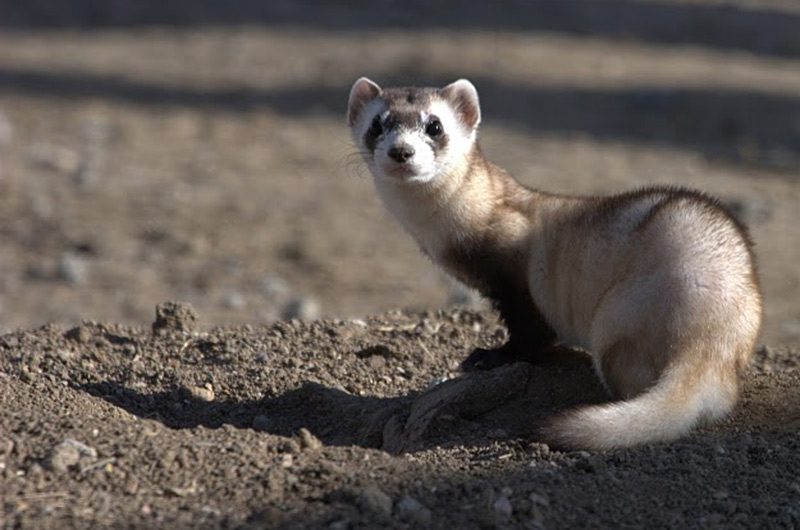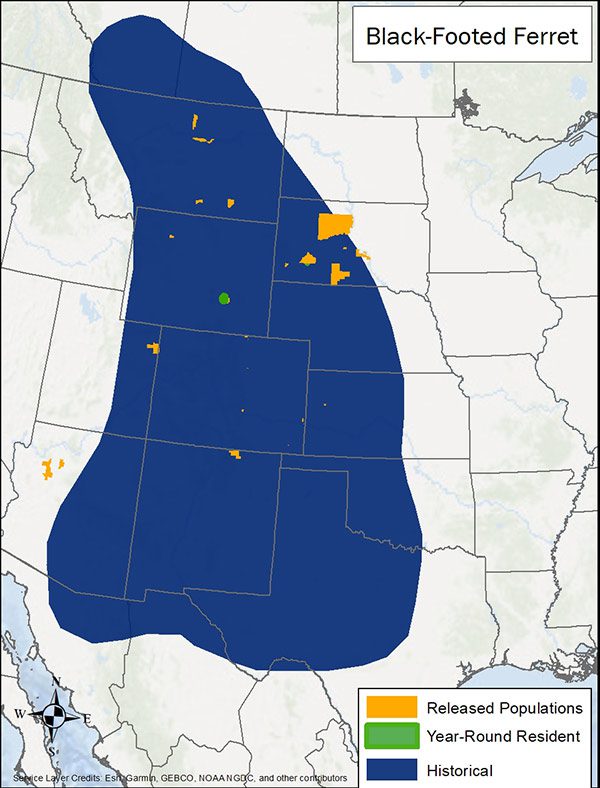LandPKS Learning
Habitat Hub

Black-Footed Ferret
The black-footed ferret is the only ferret native to the Americas. They were once considered extinct in the wild until a small isolated population was discovered in Wyoming in 1981. In 1987, the last 18 wild ferrets were captured to establish a captive breeding program. Five hundred black-footed ferrets are now estimated to be alive in the wild, after reaching around 1,000 individuals at the end of the 2000s.
Mustela nigripes
Identification
The black-footed ferret is a medium-sized mustelid, a member of the weasel family. Adult ferrets are similar in size to mink and weigh between 1.4-2.5 lbs/0.6-1.1 kg. They have black feet, a black-tipped tail, and a black face mask. The rest of their fur is a buff-beige color, which lightens to a nearly white color around their forehead, muzzle, and throat.
Black-footed ferrets once lived throughout the Great Plains wherever prairie dog colonies (black-tailed, white-tailed, and Gunnison’s prairie dogs) were found. Today they are considered Extinct in Canada and Endangered in the United States. A captive breeding program has enabled reintroduction efforts across the western United States, southern Canada, and northern Mexico.
Observation Tips
Black-footed ferrets are solitary and spend most of their time underground in prairie dogs burrows, searching for food, raising their young, sleeping, and sheltering from predators. Mating season is March and April, with litters typically producing 3 to 5 kits born in May and June. When kits are about two months old, mothers move their litter from burrow to burrow and begin teaching their kits how to hunt prairie dogs.
Ferrets are nocturnal and may be seen while spotlighting if a ferret is traveling above ground between prairie dog burrows. They have an unmistakable emerald green eyeshine.
Interesting Fact
The black-footed ferret is the only ferret native to the Americas. They were once considered extinct in the wild until a small isolated population was discovered in Wyoming in 1981. In 1987, the last 18 wild ferrets were captured to establish a captive breeding program. Five hundred black-footed ferrets are now estimated to be alive in the wild, after reaching around 1,000 individuals at the end of the 2000s.
Ideal Habitat
Historically, black-footed ferrets were found in shortgrass prairie, mixed-grass prairie, desert shrubland, shrub-steppe, sagebrush steppe, mountain grassland, and semi-arid grassland. Black-footed ferret depend exclusively on prairie dog colonies for food, shelter, and raising young. Prairie dogs comprise approximately 90% of the black-footed ferret’s diet, with alternate prey being ground squirrels, rabbits, and deer mice.
If prairie dog colonies are too small or the distance between colonies is too large, black-footed ferrets cannot sustain their populations. Shallow, well-drained, silty clay loam, sandy clay loam, or loam soils with a slope <15% are ideal for prairie dog burrow construction and, therefore, also ideal for ferrets.

Range map provided by International Union for Conservation of Nature and US Fish and Wildlife Service
Management Activities that Benefit Species – Best Management Practices (BMPs)
To benefit the black-footed ferret, avoid disturbance to open grasslands and prairies, where this species occurs. Ferrets are very susceptible to nonnative diseases such as sylvatic plague and canine distemper. Captively bred individuals are vaccinated against canine distemper; however, wild-born young are at risk of contracting the disease.
If ferrets are on or near your property, consider working with state wildlife agencies to vaccinate prairie dogs against plague to ensure ferrets have a reliable food source. As the captive breeding program successfully raises young black-footed ferrets, additional reintroduction sites are needed. If you have large areas with contiguous prairie dog colonies, consider allowing reintroduction on your property.
Management Activities to Avoid
Avoid eradicating or reducing prairie dog populations if black-footed ferrets are nearby, as these colonies are necessary for the survival of the ferret.
Other Species that Benefit from Similar Habitat Management
Other species that may benefit from habitat management for black-footed ferrets are other species dependent on prairie dog colonies and complexes including burrowing owls, rattlesnakes, and mountain plover.
Download
Download the Black-footed Ferret Factsheet
Descarga la ficha de hurón de patas negras
Other Resources
International Union for Conservation of Nature (IUCN). 2014. The IUCN Red List of Threatened Species. Version 2021-1 Black-footed ferret
NatureServe, 2019. NatureServe Explorer: An online encyclopedia of life [web application]. Version 7.1. NatureServe, Arlington, Virginia. Black-footed ferret
U.S. Fish & Wildlife Service, Black-footed ferret
U.S. Fish & Wildlife Service, New Hope for ferrets.
U.S. Geological Survey, Recovery of the black-footed ferret: Progress and Continuing Challenges
Photo Credit: J. Michael Lockhart, courtesy of USFWS/Flickr
Mobile App | Data Portal | Knowledge Hub | Habitat Hub | Learning Collections | Blog | About | Contact | Support



